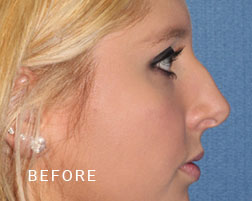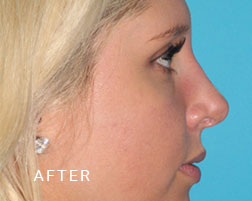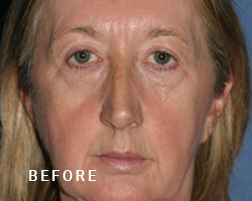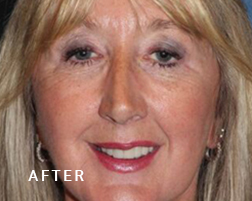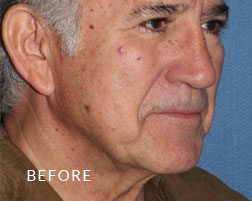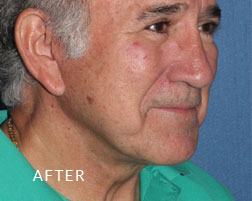Ultrasonic Preservation Rhinoplasty
Offered at our convenient location in Scottsdale, Arizona
Ultrasonic Preservation Rhinoplasty is a nasal surgery that uses an ultrasonic device to alter the shape of the nose. This technique has several advantages over traditional rhinoplasty procedures. This shaping involves not only a precise way to mobilize and move the delicate nasal bones, but also allows the surgeon the ability to carve and sculpt the nasal skeleton in way never before possible. These techniques allow the PRESERVATION of many nasal structures that in the past were traumatized by excessive cutting and manipulation. With PRESERVATION RHINOPLASTY TECHNIQUES, many of these invasive approaches have been eliminated. Most significantly by utilizing an Ultrasound Preservation approach, surgeons can create precise alterations to the nose in a more gentle manner. Patients are able to achieve elegantly shaped results with less recovery time. During a rhinoplasty, or nose job, surgeons manipulate the existing structures of the nose to improve appearance and airflow, and also typically remove and manipulate areas of nasal bone. Until recently, this required the use of surgical chisels, hammers, clippers, and rasps, which while being an effective way to create the desired effect, subjected the surrounding soft tissue to considerable trauma. Thankfully, this can now be more delicately performed thanks to advances in the ultrasound preservation technology.
Dr. Andrew Wolin is dedicated to offering his patients the latest in medical technology so that they can enjoy smooth procedures, more comfortable recoveries, and beautiful results. If you’ve been considering a rhinoplasty, you deserve the advantages of ultrasonic preservation rhinoplasty. The Wolin Plastic Surgery Center is one of the few practices in the Phoenix areas to feature this innovative technology. To learn more about ultrasonic preservation rhinoplasties and how you can benefit from this procedure, schedule an appointment for a personal consultation. You can reach our Scottsdale office by calling (480) 945-8440.
Contents
About
According to the American Society of Plastic Surgeons, 352,555 rhinoplasties were performed in 2020 alone. For patients seeking aesthetic enhancements, a rhinoplasty will typically involve eliminating a “hump” on the bridge of the nose, narrowing the nasal pyramid, and correcting asymmetry.
Despite the delicate nature of this facial feature, surgeons have traditionally been forced to resort to less than ideal ways to perform the necessary osteotomy, or removal of bone. The small area of bone often responsible for an unwanted “hump” or exaggerated bridge are in fact two bones adjacent to sensitive tissues. Using surgical hammers and chisels to create the breakage necessary to slim this area often led to additional fracture lines that compromised the structure of the nose and affected the quality of the results. Furthermore, the impact of the osteotomy invariably injured the surrounding soft tissue, leading to swelling, bruising, and the tell-tale black eyes. Luckily, today there’s a better way.
Ultrasonic Preservation Rhinoplasty
Ultrasonic vibrations are created by an electrical current to generate ultrasonic waves. These waves are generated by pressurized ceramic cylinders in the device creating small vibrations that travel from the handpiece into the bone, allowing for precise cutting, rasping, and polishing. Because these waves are so delicate and are absorbed only by the bone, they avoid causing damage to the surrounding areas of soft tissue. They also cause minimal damage to the bone being sculpted, so surgeons are able to create precise alterations without unwanted fractures or necrosis. Ultrasonic surgery allows surgeons to perform osteotomies more accurately than ever before.(1)
Dr. Wolin has been performing rhinoplasties for over 30 years and has over 1000 beautiful noses to his credit. To continue offering his patients the very best aesthetic and functional outcomes, he consistently pursues the latest in surgical technology, and ultrasonic rhinoplasty is no exception. The accuracy of this technology allows him to sculpt noses that perfectly compliment the unique facial features of each of his patients.
Benefits of Ultrasonic Preservation Rhinoplasty
Ultrasound preservation surgery allows Dr. Wolin to perform rhinoplasty surgery precisely and gently. Preservation techniques can be applied to the. bones as well as the cartilage of the nose and limit the amount of bone and soft tissue disruption often seen in standard rhinoplasty techniques.
A rhinoplasty done using Ultrasonic Preservation techniques ensures:
- Reduced bleeding
- Less trauma to the soft tissue
- Less postoperative swelling
- Minor periorbital ecchymosis (black eyes)
- Greater accuracy in sculpting bone
- Better surgical view of the treatment area (2)
Candidates
Ultrasonic rhinoplasties are performed using an open rhinoplasty approach, in which the skin of the nose is lifted away to allow the surgeon access to the inner structures of the nose. With direct vision of the nasal structures, the bone can be sculpted and mobilized at the same time that the cartilage structures are preserved. This results in less overall nasal trauma and less chance for nasal surface irregularities to be present in the final result.
Personal Consultation
The best way to determine whether you would benefit from an ultrasonic preservation rhinoplasty is to schedule a personal consultation with Dr. Wolin. After examining your nose, reviewing your medical history, and understanding your desired results, Dr. Wolin will be able to propose a rhinoplasty approach that meets your needs. The office will schedule a dedicated nasal analysis session with you and Dr. Wolin so that you and he (as well as a family member) can visually evaluate the possible structural outcomes which Dr. Wolin generates using computer imaging. Dr. Wolin feels that this allows him to better understand the inner psyche of each patient and better meet their aesthetic needs. To learn more about the services offered at our Scottsdale offices, schedule an appointment for a personal consultation. You can reach us by calling (480) 945-8440.
Preparation
After determining your candidacy for an ultrasonic rhinoplasty, Dr. Wolin and his staff will give you personalized instructions on how to prepare so that you can enjoy a smooth procedure with optimal results. Staying in good health and getting plenty of rest before your rhinoplasty will ensure that your body is in prime condition. However, rest will be just as important during your recovery. Please be prepared to take at least a week off of work, and designate a comfortable, quiet place in your home to recover.
Be sure to have soft foods and prescribed medications on hand, and plenty of pillows to keep your head elevated.
Procedure
After arriving at our Scottsdale office’s onsite, accredited operating suite, you’ll have the opportunity to review the details of your procedure and have any lingering questions or concerns addressed by Dr. Wolin. You’ll then be prepared for surgery, made comfortable, and administered a twilight anesthesia. This combination of sedatives and long-lasting local anesthesia will ensure that you remain comfortable during and after your procedure. You’ll be monitored by a professional anesthesiologist, but avoid many of the risks and side effects associated with general anesthesia. And best, of all, the local anesthesia will ensure that you remain numb for the rest of the day after your procedure.
Once the anesthesia takes effect, Dr. Wolin will make incisions around the nose that allow him to separate and lift the skin from the underlying nasal structures. Once the skin is retracted, he will then be able to begin the ultrasonic portion of the procedure. The gentle vibrations and interchangeable surgical attachments will allow him to delicately and accurately shave, incise, and polish away nasal bone to create the attractive, streamlined nose that the patient desires. Once finished with structural adjustments, the skin is redraped and sutured into place in such a manner as to avoid any noticeable scarring. Small pieces of cotton will be placed in the nasal cavity to absorb any fluid, and the nose will be dressed with supportive splints, tape, and bandages. Soon, the anesthesia will wear off, and the patient will be able to return home pain-free.
Recovery
As with any invasive procedure, swelling and bruising are to be expected. However, the recovery from an ultrasonic preservation rhinoplasty is considerably easier than that of a traditional nose job. Once the local anesthesia from the procedure wears off, patients will be able to manage discomfort with the prescribed pain medication and gentle applications of cold compresses. And, rather than having a nasal cavity packed with gauze, Dr. Wolin will remove the small pieces of cotton from their noses the next day. The supportive dressings and sutures applied at the conclusion of the procedure will be removed a week later, and within another week, any visible swelling and bruising will be resolved. Patients will be able to return to light activity in 1-2 weeks, and more strenuous activities within 4-6 weeks.
Results
Ultrasonic Preservation rhinoplasty allows a precise, gentle approach to rhinoplasties and enables sophisticated alterations to the nasal bone. The ability to sculpt and incise without damaging the surrounding tissues and ensuring the healthy recovery of the bone means that patients get to enjoy a shorter recovery and their final results much sooner! Combined with Dr. Wolin’s surgical experience and discerning eye, patients are able to achieve the nose they desire. And, with a healthy, undamaged inner structure of the nose, patients’ results will continue to complement their faces for the rest of their lives.
Cost
The best way to learn about pricing for Ultrasonic Preservation Rhinoplasty is to schedule an appointment for a personal consultation with Dr. Wolin. Your unique anatomy and aesthetic goals will determine the extent of your surgery, the techniques required, and the ultimate cost.
References
- Ghavimi MA, Nezafati S, Yazdani J, et al. Comparison of edema and ecchymosis in rhinoplasty candidates after lateral nasal osteotomy using piezosurgery and external osteotomy. J Adv Pharm Technol Res. 2018;9(3):73-79. doi:10.4103/japtr.JAPTR_294_18
- Robiony M, Franz L, Costa F, Bianchi A, Marchetti C. Piezosurgery: A True Revolution for Nasal Bone Osteotomies in Rhinoplasty. Plast Reconstr Surg Glob Open. 2016;4(6):e788. Published 2016 Jun 29. doi:10.1097/GOX.0000000000000769




